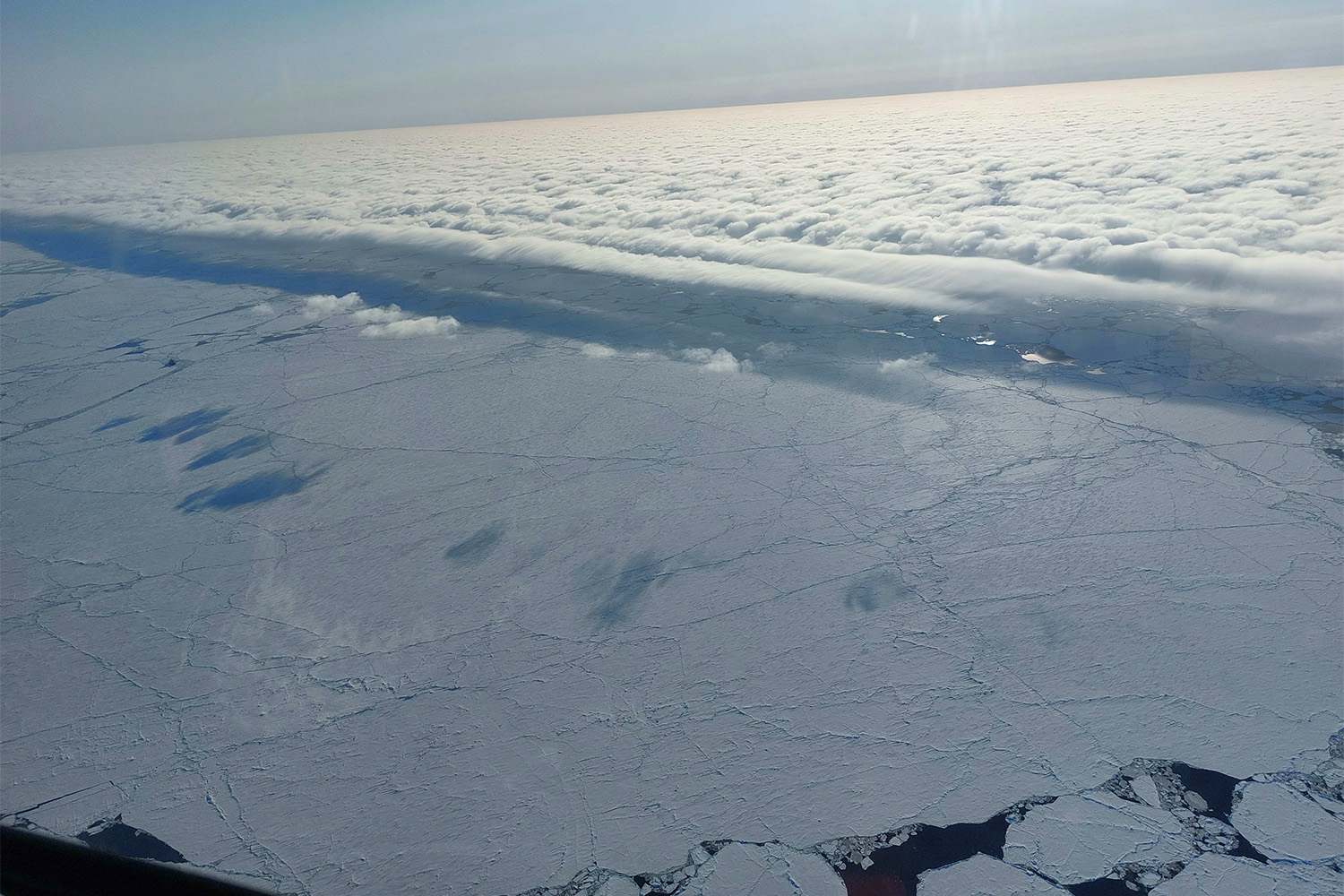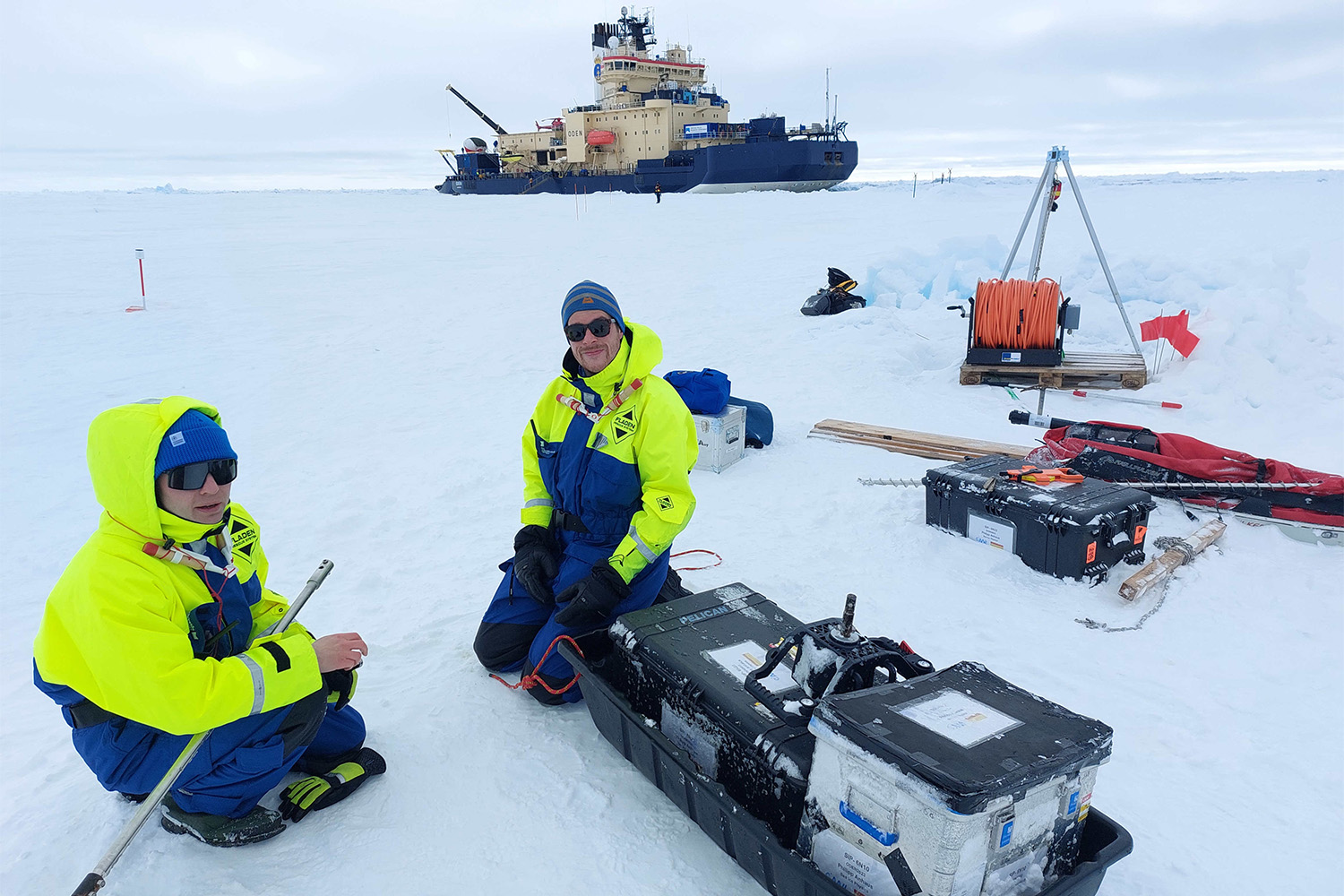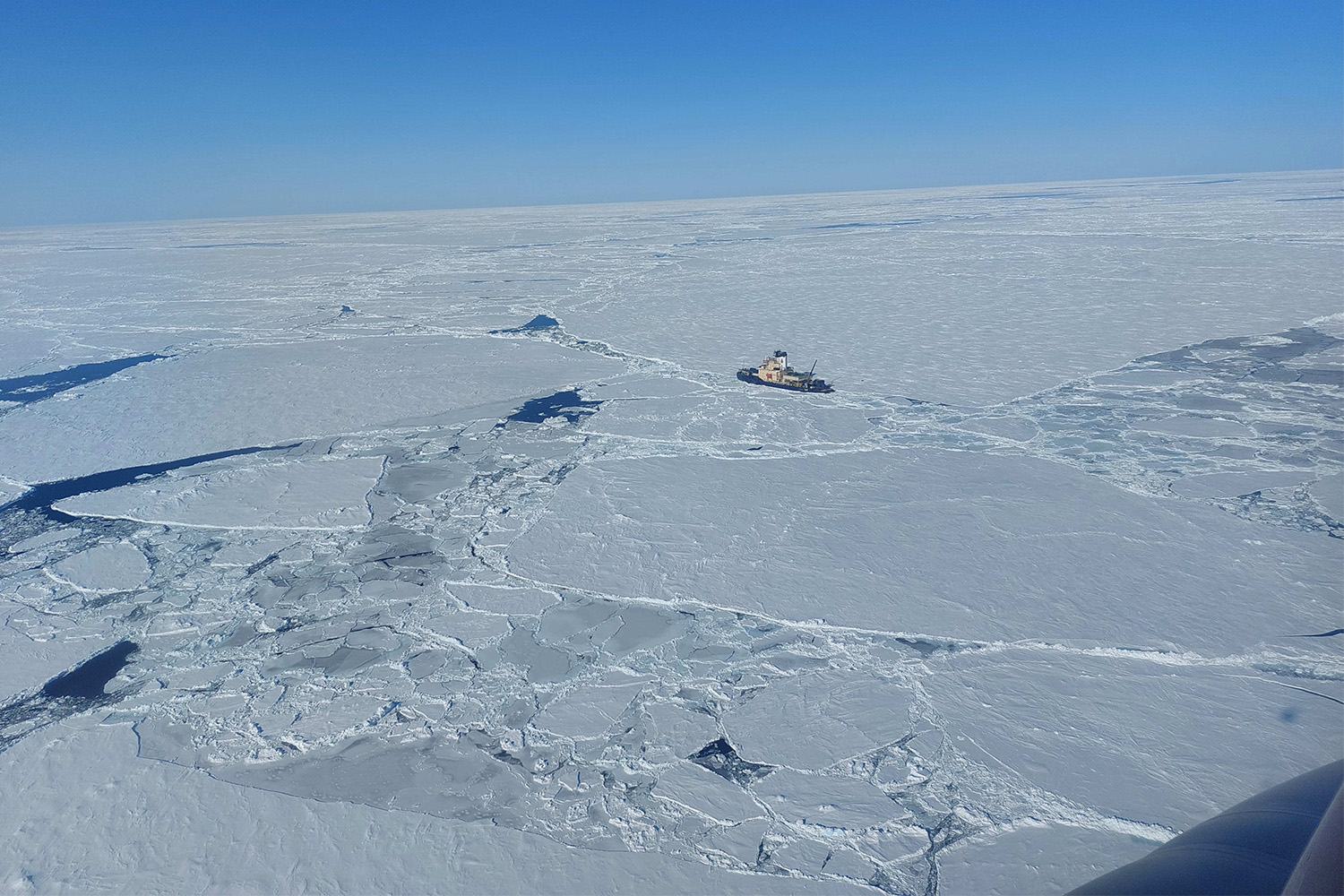Mail from the ice (1) Magnus Asmussen and Dr.-Ing. Falk Pätzold report from Arctic expedition
In May 2023, the research vessel “Oden” set off for the Arctic. On the Swedish expedition “ARTofMELT” (7 May to 15 June), the researchers observe weather, air and water. They want to find out why and when the ice begins to melt and which processes are important for melting. Two scientists from Technische Universität Braunschweig also went on board. Their emails give us a small insight into their work and everyday life during their research trip. The collected measurement data can be used to investigate which processes have which influence. The data is also used to test and improve models.
All episodes: Mail from the ice (1) | Mail from the ice (2) | Mail from the ice (3)

Above the clouds: The sea ice edge, photographed from a helicopter. Photo credit: IFF/TU Braunschweig
From: Falk Sent: 10.05.2023, 22:32
After a normal arrival (started on Saturday at 03:15 at Braunschweig main station, train arrived 55 minutes later, Saturday afternoon perfect weather in Oslo), a sunny start towards Longyearbyen [largest town of the Spitsbergen archipelago – ed.] and a short boat trip, we settled into the cabins and containers on Monday, listened to the explanations and demonstrations about safety on and next to the ship and then, in the late afternoon, tried out craning the HELiPOD onto the helicopter deck with the deck crew. At midnight sharp, local time, the little ship chugged off.
The following Tuesday we reached the ice edge in the afternoon (the ship’s time had been set back two hours to UTC in the meantime) and then parked about three hours later at a larger floe in the so-called margial ice zone (MIZ).
The HELiPOD crane training from the previous day paid off because, considering the not-so-great weather forecasts for the next three days, a flight was then scheduled and completed that evening. The pilot was able to handle external loads very well and had done the pick up and set down on the helideck very safely. We had flown just under 50 km north and then south from the ship on this flight and could see significant gradients in some readings. 23 hours after departure we have the first measurement flight in the can!

Magnus Asmussen and a colleague in front of the icebreaker “Oden”. Photo credit: IFF/TU Braunschweig
While I have a somewhat mono diet with the HELiPOD, my colleague Magnus indulges in various other construction sites and today he and his team deployed the probe for deep-sea investigations (CTD = Conductivity, Temperature, Depth). Today, in cloudy weather and light frost, there was a fluffy, shallow, storybook snowfall all day again. As of 18:00 (UTC) we are moving again, heading northwest towards northeast Greenland to get closer to a forming area of high pressure.
From: Magnus Sent: 12.05.2023, 19:45
On the way out of Spitsbergen we saw a few pilot whales. The next day we saw the first black spot on the ice floe (polar bear). The day before yesterday, there was a very curious bear that was poking around on a floe quite close to the stern and then took off after hearing the ship’s horn blow three times.
The daily routine is based around the well-timed meal times. From 12 to 6 pm I also have an acoustic shift on the bridge and, with the support of an Irish woman, I monitor a multibeam (topography of the floor), an SBP (stratification of the upper sediment layers) and two acoustic instruments that resolve the stratification in the water. I also have the fish camera in my care at the moment, which needs to be adjusted with a lot of sensitivity before each CTD cast.
The forecast for tomorrow is bad weather, a lot of wind and precipitation (the form of the precipitation is still being debated). But since tomorrow is Saturday, dinner will be a bit more refined and the food is supposed to be even better. The “Oden” has just got stuck on a floe to ride out the bad weather.
The food here is just super good, the kitchen always conjures up exciting and super tasty meals – vegetarians usually eat vegan, but luckily you can slather a sandwich with cheese on your own 😀 By the way, on Thursdays there are always pancakes with ice cream and also pea soup. Experienced “Oden” drivers think that later, this is the best proof that it’s Thursday again. Due to the constant sunlight, you somewhat lose track of what time it is.
After the turmoil of breaking ice, the goal now is to break through to the north. At the moment we are sitting on a floe at 80 27.4637N and 0 28.2157E, so effectively on the zero meridan 🙂
From: Magnus Sent: 15.05.2023, 13:38
The HELiPOD set off again today at 10:30 UTC into the cold, white expanses. After it stormed and snowed at the weekend, the cutter is now trying to make its way north with all its might. In the meantime, the weather has cleared up a bit. The plan is to moor at a floe on Tuesday/Wednesday and set up a more permanent station for the surveys.
As we are also stuck in Greenlandic waters, we are not allowed to ping and record the permanent oceanographic measurements at the moment. At the ice station, we go out on the ice for all kinds of measurements, microprofiles of the water column, ice and snow samples, sawing/cutting/drilling holes, and lots more nice stuff.
Yesterday was another birthday on the ship. That meant delicious cake, and in the evening there was a games evening. So once again, the cuisine here is excellent, and neither Falk nor I will be losing any weight here. The mood is generally good and the first week is complete.
From: Falk Sent: 17.05.2023, 18:22 Subject: Water level report
“Ice or sun level” also works, of course, because we have both extensively right now. Since Sunday we have been under the influence of a high-pressure bridge between a low-pressure area in the area of the North Pole and a low-pressure area passing through to the south. The wind comes from different directions, mostly with 15 to 25 km/h; the temperatures vary between -8 and -15 °C depending on the position of the sun.
The HELiPOD flew scientifically successfully on Monday morning. We then started yesterday with renewed vigour, and so yesterday was a deck and flight operation that left clear traces of satisfaction, not only scientifically. With the three flights we now have a very good basis for the condition before the melting season begins.
Tuesday morning the ship moored at a floe, which is now being taken into use. Here Magnus has had a run and is frolicking in the snow like a young dog. At the same time, the so-called Helikite (a helium balloon with a direction-stabilising fin underneath) stays in the air a little longer, so the helicopter is forced to take a break, which comes in handy for the purpose of sorting and repairing various small construction sites (this is where Lutz comes in again to sort out the many little details by email). On the floe, ice cores will be taken, small samples of snow will be taken, a meteorological mast will be set up, and whatever else needs to be done. Work on this floe is expected to continue until Saturday, when it’s hoped that the melting season will begin and we will go to the places where, according to the weather models, there are supposed to be warm air bursts in order to study the processes that then begin in more detail.

View of the “Oden” and research environment in the Arctic. Photo credit: IFF/TU Braunschweig
From: Magnus Sent: 18.5.2023, 14:00
After the successful HELiPOD flight, which even elicited a smile from the North Swedish (reserved) helicopter pilot, I had the opportunity to trudge out onto the ice again after dinner until 9 pm. To the amusement of our Swedish company, a colleague and I then toiled at the ice hole, which is said to have an approximate size of 1.2 x 1.1 m at the end. That day we made a few breakthroughs through the ice, but due to the ice thickness of about 1.8 m, the ice saws were simply not long enough.
From: Falk Sent: 20.05.2023, 22:30
Yesterday, Friday, two HELiPOD flights could be completed. While it didn’t look good at first because of unpredicted very low clouds, the first round could start around half past ten. However, the weather was only semi-stable and the possible flight path limited: We are not at the edge of the ice, but the dynamics of sea and air currents had created ice-free areas to the south and west of our position, the size of which must be at least as large as Lake Constance. Flights over open water, however, are subject to severe restrictions, and so we headed in the two other cardinal directions. Timing is important when evaluating yesterday’s two flights, because it was the day of the beginning of the melting season. What processes take place in this phase of the Arctic climate is what the whole trip is about. At MOSAiC there was a forced pause right at this time, and overall this phase is probably rather poorly understood so far compared to its autumnal counterpart.
After this first very fantastic flight, I asked the flight leader for another one, which he made possible in an inimitable calm manner. 5 flights down … nice.
And outside, meanwhile, things are also getting damp on the decks, as the current low-pressure area is now bringing delicious sleet. The accompanying fog = overlying clouds brought work on the ice to a standstill today due to polar bear-camouflaging low visibility. Tomorrow we will work on the floe again, clear everything away and then head north again. The weather conditions for further helipod flights are now becoming more difficult.
After almost two weeks, a certain fatigue has set in among the crew.
All episodes: Mail from the ice (1) | Mail from the ice (2) | Mail from the ice (3)
